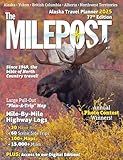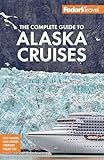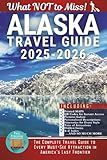Best Routes to Alaska to Buy in January 2026

Fodor's Alaska (Full-color Travel Guide)



The MILEPOST 2025: Alaska Travel Planner



Fodor's The Complete Guide to Alaska Cruises (Full-color Travel Guide)



Alaska – What NOT to Miss: The Complete Travel Guide to Every Must-See Attraction in America’s Last Frontier



Alaska Cruise Travel Guide 2025/2026: A Tour Book to Cruising Alaska’s Wild Coast: Real Tips, Season Planning & Local Secrets For Your Trip…. Includes Pictures And Maps



Fodor’s Alaska (Full-color Travel Guide)



Lonely Planet Alaska (Travel Guide)



Moon Alaska: Scenic Drives, National Parks, Best Hikes (Moon U.S. Travel Guide)


Yes, it is possible to get to Alaska by land. However, reaching Alaska solely by road depends on where you are starting from, as Alaska is geographically disconnected from the continental United States. To access Alaska by land, you would typically begin your journey in the contiguous U.S. and travel through Canada.
The most common land route to Alaska is through Canada's western provinces of British Columbia, Alberta, and Yukon Territory. Travelers usually begin their journey on the Alaska Highway, which starts in Dawson Creek, British Columbia. The Alaska Highway stretches for approximately 1,387 miles (2,232 kilometers) and passes through stunning landscapes, including vast forests, mountain ranges, and pristine wilderness.
Along the way, you will encounter several towns and services, making it relatively convenient to find accommodations, supplies, and fuel. Notable locations include Fort Nelson, Liard River Hot Springs, Watson Lake (where the famous Sign Post Forest is located), Whitehorse in Yukon Territory, and Tok in Alaska. The highway is well-maintained, although it is wise to check road conditions before setting off on your journey, especially during winter when some parts may be covered in snow or ice.
While the Alaska Highway is the primary access route, it is not the only way to reach Alaska by land. Depending on your starting location, you can also consider other routes, such as the Stewart-Cassiar Highway through western British Columbia or the Haines Highway in southeastern Alaska connecting Haines, Alaska, to Haines Junction, Yukon.
It is important to note that traveling to Alaska by road requires crossing international borders into Canada and potentially back into the United States. Hence, you should ensure you have the necessary documentation, such as a valid passport, and be aware of any visa requirements specific to your citizenship.
The journey to Alaska by land is an incredible adventure, offering the opportunity to witness breathtaking landscapes and wildlife. It is recommended to plan your trip well, considering the distance, weather conditions, and available services to ensure a safe and enjoyable experience.
How to navigate through mountainous regions on the way to Alaska?
Navigating through mountainous regions on the way to Alaska requires careful planning and preparation. Here are some tips to help you navigate through this challenging terrain:
- Study Maps and Get a GPS: Acquire detailed maps and a reliable GPS device to plan your route. Familiarize yourself with the road systems and the mountainous areas along the way. Ensure your GPS is up to date and has maps for the regions you'll be traveling through.
- Research Road Conditions: Check road condition reports before you start your journey. Mountainous regions can experience unpredictable weather conditions, and roads can sometimes be closed or restricted. Websites like Alaska 511 or local transportation departments provide updated road information.
- Plan Your Stops: Identify towns or rest areas where you can take breaks, refuel, and restock supplies. Plan your fuel stops strategically, especially in remote mountainous regions where gas stations may be infrequent.
- Be Prepared: Carry essential supplies like food, water, warm clothing, a first aid kit, emergency tools, and extra fuel. Ensure your vehicle is in good condition, including tires suitable for the mountainous terrain.
- Drive Carefully: Mountainous terrains can be challenging to navigate, so drive cautiously. Keep an eye out for sharp curves, steep grades, and potential hazards like falling rocks or wildlife. Stay within the speed limits, and be mindful of the weather conditions.
- Take Breaks Safely: When you need to stop and rest or enjoy the scenery, find safe pullouts or designated stops. Avoid parking in areas that may obstruct traffic or pose a danger to yourself and others.
- Check Weather Forecasts: Monitor weather forecasts regularly, especially in mountainous areas. Prepare for sudden changes in weather conditions and be prepared to adjust your plans accordingly.
- Stay Connected: Inform someone about your travel plans and estimated arrival time. In remote areas, mobile signal reception can be weak or non-existent, so consider carrying a satellite phone or a two-way radio for emergency communication.
- Seek Local Knowledge: Talk to locals or people who have previously traveled through the region. They can provide valuable information about road conditions, scenic spots, campgrounds, and any other tips specific to the area.
- Enjoy the Journey: Traveling through mountainous regions on the way to Alaska offers stunning scenery and unique experiences. Take the time to appreciate and enjoy the beauty of the landscapes, but always prioritize safety and be prepared for any challenges that may arise.
Remember, the conditions in mountainous regions can be unpredictable, so always prioritize safety and make sure you are well-prepared before embarking on your journey.
How to budget for a road trip to Alaska?
Planning and budgeting for a road trip to Alaska requires careful financial planning and consideration. Here are some steps to help you budget for your journey:
- Determine your route: Decide on the route you will take to Alaska and back. Research and make note of the towns, cities, and attractions you plan to visit along the way.
- Estimate fuel costs: Calculate the total mileage for your trip, and then estimate the fuel consumption of your vehicle per mile. Multiply the two to get an approximate cost for fuel. Keep in mind that gas prices may vary significantly, so consider having some buffer funds for unexpected price hikes.
- Set a daily budget: Decide on a daily budget that covers essential expenses such as accommodation, food, and activities. Research the costs of hotels, campsites, and dining options in each location you plan to stay at. Consider cooking your own meals occasionally to save money.
- Account for vehicle maintenance: Since it's a long drive, your vehicle might need some maintenance or repairs along the way. Account for oil changes, tire rotations, and general inspections to ensure your vehicle remains in good condition throughout the trip.
- Plan for attractions and activities: Research the various attractions, national parks, museums, and activities available along your route. Look for their admission fees or costs, and include these expenses in your budget.
- Save on accommodations: Consider camping in national parks or using affordable accommodation options like motels, hostels, or camping grounds to save money. Additionally, look for deals and discounts on accommodation websites or apps.
- Account for entry fees and permits: If you plan to visit national parks or protected areas, be aware of any entry fees or permits required, and include them in your budget.
- Estimate food expenses: Determine how much you are willing to spend on meals each day. Opting for grocery shopping and cooking your own meals can significantly reduce costs. Additionally, bring snacks and drinks from home to avoid buying them at higher prices on the road.
- Include miscellaneous expenses: Account for miscellaneous expenses such as tolls, parking fees, souvenirs, and unforeseen expenses. Add a buffer amount to your budget for emergencies or unexpected situations.
- Track your expenses: While on the road, keep track of your expenses to ensure you stay within your budget. Apps, spreadsheets, or even a simple notebook can help you record your spending.
Remember, it's essential to be flexible and adaptable during your trip, as unexpected situations and expenses may arise.
What is the availability of gas stations on the road to Alaska?
The availability of gas stations on the road to Alaska depends on the specific route you take. If you are driving from the contiguous United States through Canada, particularly via the Alaska Highway (Highway 97), which is the most common route, gas stations are generally available at regular intervals.
While the frequency of gas stations can vary, they are typically found every 100-200 miles (160-320 kilometers) along the major highways. However, it is important to note that the farther north you go in Canada or Alaska, the more limited the availability of gas stations becomes. In some remote areas, gas stations may be several hundred miles apart, so it is crucial to plan your fuel stops accordingly and ensure you have enough gas to reach the next station.
Additionally, it's always a good idea to have extra fuel, especially if you plan to explore more off-the-beaten-path areas or venture onto smaller roads where gas stations may be scarce. It is advisable to carry extra fuel cans and be prepared for longer stretches without gas stations in certain remote regions.
What is the weather like on the road to Alaska?
The weather on the road to Alaska can vary significantly depending on the time of year and the specific route you take. Generally, it is characterized by diverse and changeable conditions. During the summer months (June to August), the weather is typically warmer with average temperatures ranging from 50°F to 70°F (10°C to 25°C). However, it can still rain frequently, and the interior regions may experience thunderstorms. It is advisable to pack for both warm and colder conditions and be prepared for rain.
During the shoulder seasons of spring and autumn, the weather becomes more unpredictable. Snow and ice can still be present in higher elevations, especially in the early spring (March to May) and late autumn (September to November). Temperatures also become cooler, with average highs ranging from 30°F to 50°F (-1°C to 10°C) during these seasons.
In winter (December to February), the road to Alaska experiences extreme cold, heavy snowfall, and challenging driving conditions. Temperatures can drop well below freezing, often reaching -20°F to -40°F (-29°C to -40°C) in some areas. It is recommended to have appropriate winter tires and be prepared for potential road closures and hazardous weather conditions during this time.
It is essential to check weather forecasts and road conditions before embarking on a journey to Alaska and be ready to adjust your plans accordingly to ensure a safe and comfortable trip.
What is the estimated travel time to reach Alaska by land?
The estimated travel time to reach Alaska by land depends on various factors such as starting location, chosen route, mode of transportation, and personal travel speed. However, the most common way to reach Alaska by land is through Canada. If starting from the contiguous United States, the estimated travel time can range between 4 to 7 days or more, depending on the distance, driving conditions, and how much time is spent each day on the road. It is important to consider rest stops, overnight stays, and potential delays due to weather, road conditions, or border crossings.
How to ensure a smooth border crossing on the way to Alaska?
To ensure a smooth border crossing on your way to Alaska, here are some steps you can follow:
- Research: Gather information about the current border regulations, entry requirements, and any travel restrictions related to COVID-19. Check the websites of the U.S. Customs and Border Protection (CBP) and the Canadian Border Services Agency (CBSA) to stay updated.
- Prepare Required Documents: Ensure you have all the necessary identification and travel documents ready, including passports, visas (if applicable), and any supporting documents such as a letter of employment or itinerary. Make copies of these documents and keep them in a safe place.
- Plan Your Itinerary: Plan your route while keeping in mind that there are limited border crossings available on the way to Alaska. The most common routes are through British Columbia via either the Peace Arch Border Crossing (Interstate 5) or the Eastport Border Crossing (Highway 95). Check the opening hours of the chosen border crossing, as some may have limited hours of operation.
- Declare Your Intent: When you reach the border, clearly communicate your intentions to the border officers. Mention that you are heading to Alaska and provide any necessary documentation to support your claim, such as hotel reservations or a planned itinerary.
- Be Honest and Transparent: Answer all questions truthfully and provide any required information to the border officers. Avoid making false statements or attempting to withhold information, as it can lead to complications or even legal issues.
- Follow COVID-19 Guidelines: Due to the ongoing pandemic, there might be additional COVID-19 related entry requirements. Make sure to comply with these regulations, such as providing negative test results, showing proof of vaccination, or following quarantine protocols as necessary.
- Carry Essential Supplies: When traveling through remote areas, it's wise to carry extra supplies like food, water, warm clothing, and emergency equipment in case of unexpected delays or breakdowns. This will help ensure your comfort and safety during the journey.
- Stay Informed: Stay updated on any changes in border policies and the latest advisories by checking official government websites, social media channels, or contacting the embassy or consulate. Stay informed about the border crossing conditions, road closures, or any construction detours along your chosen route.
Remember, border crossing rules and procedures can change, so it's essential to stay informed and allow ample time for potential delays. Cooperation, honesty, and thorough preparation will greatly enhance your chances of a smooth border crossing on the way to Alaska.
